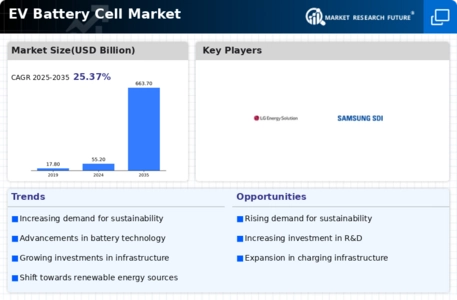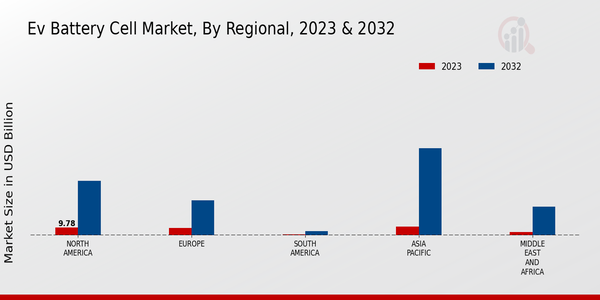Market Growth Projections
The Global EV Battery Cell Market Industry is poised for remarkable growth, with projections indicating a market size of 55.2 USD Billion in 2024 and an anticipated surge to 663.7 USD Billion by 2035. This growth trajectory suggests a compound annual growth rate of 25.37% from 2025 to 2035, reflecting the increasing adoption of electric vehicles and advancements in battery technology. The market's expansion is driven by various factors, including rising consumer demand, government incentives, and technological innovations. As the industry evolves, it is likely to attract significant investments, further fueling its development.
Government Incentives and Policies
Government incentives and policies play a crucial role in promoting the Global EV Battery Cell Market Industry. Many countries are implementing subsidies, tax credits, and rebates to encourage electric vehicle adoption. Additionally, regulations mandating the reduction of carbon emissions further stimulate the market. For instance, several nations have set ambitious targets for phasing out internal combustion engines, which directly boosts the demand for electric vehicles and, consequently, battery cells. These supportive measures are expected to enhance market growth, as consumers are more likely to invest in electric vehicles when financial incentives are available.
Rising Demand for Electric Vehicles
The increasing global demand for electric vehicles is a primary driver of the Global EV Battery Cell Market Industry. As consumers become more environmentally conscious and governments implement stricter emissions regulations, the shift towards electric mobility accelerates. In 2024, the market is projected to reach 55.2 USD Billion, reflecting a significant uptick in production and sales of electric vehicles. This trend is expected to continue, with the market potentially reaching 663.7 USD Billion by 2035. The growing adoption of electric vehicles necessitates advancements in battery technology, thereby propelling the demand for high-performance battery cells.
Growing Infrastructure for EV Charging
The expansion of electric vehicle charging infrastructure is a significant driver of the Global EV Battery Cell Market Industry. As more charging stations are installed globally, the convenience of owning an electric vehicle increases, thereby encouraging consumer adoption. Governments and private enterprises are investing in charging networks to alleviate range anxiety among potential electric vehicle buyers. This infrastructure development is likely to create a positive feedback loop, where increased charging availability leads to higher electric vehicle sales, which in turn drives demand for battery cells. The synergy between infrastructure and vehicle sales is essential for the market's sustained growth.
Technological Advancements in Battery Technology
Technological innovations in battery technology are reshaping the Global EV Battery Cell Market Industry. Developments in lithium-ion batteries, solid-state batteries, and other advanced chemistries enhance energy density, charging speed, and overall performance. These advancements not only improve the driving range of electric vehicles but also reduce costs, making them more accessible to consumers. As a result, manufacturers are investing heavily in research and development to create next-generation battery cells. The anticipated compound annual growth rate of 25.37% from 2025 to 2035 indicates a robust trajectory for the industry, driven by these technological breakthroughs.
Environmental Concerns and Sustainability Initiatives
Environmental concerns and sustainability initiatives are increasingly influencing the Global EV Battery Cell Market Industry. As awareness of climate change and pollution rises, consumers and businesses alike are seeking greener alternatives to traditional fossil fuel-powered vehicles. The transition to electric vehicles is seen as a vital step in reducing greenhouse gas emissions. Consequently, manufacturers are focusing on producing battery cells that are not only efficient but also environmentally friendly. This shift towards sustainability is likely to enhance the market's appeal, as consumers prioritize eco-friendly products. The industry's alignment with global sustainability goals may further accelerate growth.




